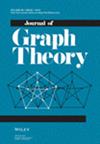求助PDF
{"title":"高连接三元组和马德猜想","authors":"Qinghai Liu, Kai Ying, Yanmei Hong","doi":"10.1002/jgt.23144","DOIUrl":null,"url":null,"abstract":"<p>Mader proved that, for any tree <span></span><math>\n <semantics>\n <mrow>\n \n <mrow>\n <mi>T</mi>\n </mrow>\n </mrow>\n <annotation> $T$</annotation>\n </semantics></math> of order <span></span><math>\n <semantics>\n <mrow>\n \n <mrow>\n <mi>m</mi>\n </mrow>\n </mrow>\n <annotation> $m$</annotation>\n </semantics></math>, every <span></span><math>\n <semantics>\n <mrow>\n \n <mrow>\n <mi>k</mi>\n </mrow>\n </mrow>\n <annotation> $k$</annotation>\n </semantics></math>-connected graph <span></span><math>\n <semantics>\n <mrow>\n \n <mrow>\n <mi>G</mi>\n </mrow>\n </mrow>\n <annotation> $G$</annotation>\n </semantics></math> with <span></span><math>\n <semantics>\n <mrow>\n \n <mrow>\n <mi>δ</mi>\n \n <mrow>\n <mo>(</mo>\n \n <mi>G</mi>\n \n <mo>)</mo>\n </mrow>\n \n <mo>≥</mo>\n \n <mn>2</mn>\n \n <msup>\n <mrow>\n <mo>(</mo>\n \n <mrow>\n <mi>k</mi>\n \n <mo>+</mo>\n \n <mi>m</mi>\n \n <mo>−</mo>\n \n <mn>1</mn>\n </mrow>\n \n <mo>)</mo>\n </mrow>\n \n <mn>2</mn>\n </msup>\n \n <mo>+</mo>\n \n <mi>m</mi>\n \n <mo>−</mo>\n \n <mn>1</mn>\n </mrow>\n </mrow>\n <annotation> $\\delta (G)\\ge 2{(k+m-1)}^{2}+m-1$</annotation>\n </semantics></math> contains a subtree <span></span><math>\n <semantics>\n <mrow>\n \n <mrow>\n <msup>\n <mi>T</mi>\n \n <mo>′</mo>\n </msup>\n \n <mo>≅</mo>\n \n <mi>T</mi>\n </mrow>\n </mrow>\n <annotation> ${T}^{^{\\prime} }\\cong T$</annotation>\n </semantics></math> such that <span></span><math>\n <semantics>\n <mrow>\n \n <mrow>\n <mi>G</mi>\n \n <mo>−</mo>\n \n <mi>V</mi>\n \n <mrow>\n <mo>(</mo>\n \n <msup>\n <mi>T</mi>\n \n <mo>′</mo>\n </msup>\n \n <mo>)</mo>\n </mrow>\n </mrow>\n </mrow>\n <annotation> $G-V({T}^{^{\\prime} })$</annotation>\n </semantics></math> is <span></span><math>\n <semantics>\n <mrow>\n \n <mrow>\n <mi>k</mi>\n </mrow>\n </mrow>\n <annotation> $k$</annotation>\n </semantics></math>-connected. We proved that any graph <span></span><math>\n <semantics>\n <mrow>\n \n <mrow>\n <mi>G</mi>\n </mrow>\n </mrow>\n <annotation> $G$</annotation>\n </semantics></math> with minimum degree <span></span><math>\n <semantics>\n <mrow>\n \n <mrow>\n <mi>δ</mi>\n \n <mrow>\n <mo>(</mo>\n \n <mi>G</mi>\n \n <mo>)</mo>\n </mrow>\n \n <mo>≥</mo>\n \n <mn>2</mn>\n \n <mi>k</mi>\n </mrow>\n </mrow>\n <annotation> $\\delta (G)\\ge 2k$</annotation>\n </semantics></math> contains <span></span><math>\n <semantics>\n <mrow>\n \n <mrow>\n <mi>k</mi>\n </mrow>\n </mrow>\n <annotation> $k$</annotation>\n </semantics></math>-connected triples. As a corollary, we prove that, for any tree <span></span><math>\n <semantics>\n <mrow>\n \n <mrow>\n <mi>T</mi>\n </mrow>\n </mrow>\n <annotation> $T$</annotation>\n </semantics></math> of order <span></span><math>\n <semantics>\n <mrow>\n \n <mrow>\n <mi>m</mi>\n </mrow>\n </mrow>\n <annotation> $m$</annotation>\n </semantics></math>, every <span></span><math>\n <semantics>\n <mrow>\n \n <mrow>\n <mi>k</mi>\n </mrow>\n </mrow>\n <annotation> $k$</annotation>\n </semantics></math>-connected graph <span></span><math>\n <semantics>\n <mrow>\n \n <mrow>\n <mi>G</mi>\n </mrow>\n </mrow>\n <annotation> $G$</annotation>\n </semantics></math> with <span></span><math>\n <semantics>\n <mrow>\n \n <mrow>\n <mi>δ</mi>\n \n <mrow>\n <mo>(</mo>\n \n <mi>G</mi>\n \n <mo>)</mo>\n </mrow>\n \n <mo>≥</mo>\n \n <mn>3</mn>\n \n <mi>k</mi>\n \n <mo>+</mo>\n \n <mn>4</mn>\n \n <mi>m</mi>\n \n <mo>−</mo>\n \n <mn>6</mn>\n </mrow>\n </mrow>\n <annotation> $\\delta (G)\\ge 3k+4m-6$</annotation>\n </semantics></math> contains a subtree <span></span><math>\n <semantics>\n <mrow>\n \n <mrow>\n <msup>\n <mi>T</mi>\n \n <mo>′</mo>\n </msup>\n \n <mo>≅</mo>\n \n <mi>T</mi>\n </mrow>\n </mrow>\n <annotation> ${T}^{^{\\prime} }\\cong T$</annotation>\n </semantics></math> such that <span></span><math>\n <semantics>\n <mrow>\n \n <mrow>\n <mi>G</mi>\n \n <mo>−</mo>\n \n <mi>V</mi>\n \n <mrow>\n <mo>(</mo>\n \n <msup>\n <mi>T</mi>\n \n <mo>′</mo>\n </msup>\n \n <mo>)</mo>\n </mrow>\n </mrow>\n </mrow>\n <annotation> $G-V({T}^{^{\\prime} })$</annotation>\n </semantics></math> is still <span></span><math>\n <semantics>\n <mrow>\n \n <mrow>\n <mi>k</mi>\n </mrow>\n </mrow>\n <annotation> $k$</annotation>\n </semantics></math>-connected, improving Mader's condition to a linear bound.</p>","PeriodicalId":16014,"journal":{"name":"Journal of Graph Theory","volume":"107 3","pages":"478-484"},"PeriodicalIF":0.9000,"publicationDate":"2024-06-17","publicationTypes":"Journal Article","fieldsOfStudy":null,"isOpenAccess":false,"openAccessPdf":"","citationCount":"0","resultStr":"{\"title\":\"Highly connected triples and Mader's conjecture\",\"authors\":\"Qinghai Liu, Kai Ying, Yanmei Hong\",\"doi\":\"10.1002/jgt.23144\",\"DOIUrl\":null,\"url\":null,\"abstract\":\"<p>Mader proved that, for any tree <span></span><math>\\n <semantics>\\n <mrow>\\n \\n <mrow>\\n <mi>T</mi>\\n </mrow>\\n </mrow>\\n <annotation> $T$</annotation>\\n </semantics></math> of order <span></span><math>\\n <semantics>\\n <mrow>\\n \\n <mrow>\\n <mi>m</mi>\\n </mrow>\\n </mrow>\\n <annotation> $m$</annotation>\\n </semantics></math>, every <span></span><math>\\n <semantics>\\n <mrow>\\n \\n <mrow>\\n <mi>k</mi>\\n </mrow>\\n </mrow>\\n <annotation> $k$</annotation>\\n </semantics></math>-connected graph <span></span><math>\\n <semantics>\\n <mrow>\\n \\n <mrow>\\n <mi>G</mi>\\n </mrow>\\n </mrow>\\n <annotation> $G$</annotation>\\n </semantics></math> with <span></span><math>\\n <semantics>\\n <mrow>\\n \\n <mrow>\\n <mi>δ</mi>\\n \\n <mrow>\\n <mo>(</mo>\\n \\n <mi>G</mi>\\n \\n <mo>)</mo>\\n </mrow>\\n \\n <mo>≥</mo>\\n \\n <mn>2</mn>\\n \\n <msup>\\n <mrow>\\n <mo>(</mo>\\n \\n <mrow>\\n <mi>k</mi>\\n \\n <mo>+</mo>\\n \\n <mi>m</mi>\\n \\n <mo>−</mo>\\n \\n <mn>1</mn>\\n </mrow>\\n \\n <mo>)</mo>\\n </mrow>\\n \\n <mn>2</mn>\\n </msup>\\n \\n <mo>+</mo>\\n \\n <mi>m</mi>\\n \\n <mo>−</mo>\\n \\n <mn>1</mn>\\n </mrow>\\n </mrow>\\n <annotation> $\\\\delta (G)\\\\ge 2{(k+m-1)}^{2}+m-1$</annotation>\\n </semantics></math> contains a subtree <span></span><math>\\n <semantics>\\n <mrow>\\n \\n <mrow>\\n <msup>\\n <mi>T</mi>\\n \\n <mo>′</mo>\\n </msup>\\n \\n <mo>≅</mo>\\n \\n <mi>T</mi>\\n </mrow>\\n </mrow>\\n <annotation> ${T}^{^{\\\\prime} }\\\\cong T$</annotation>\\n </semantics></math> such that <span></span><math>\\n <semantics>\\n <mrow>\\n \\n <mrow>\\n <mi>G</mi>\\n \\n <mo>−</mo>\\n \\n <mi>V</mi>\\n \\n <mrow>\\n <mo>(</mo>\\n \\n <msup>\\n <mi>T</mi>\\n \\n <mo>′</mo>\\n </msup>\\n \\n <mo>)</mo>\\n </mrow>\\n </mrow>\\n </mrow>\\n <annotation> $G-V({T}^{^{\\\\prime} })$</annotation>\\n </semantics></math> is <span></span><math>\\n <semantics>\\n <mrow>\\n \\n <mrow>\\n <mi>k</mi>\\n </mrow>\\n </mrow>\\n <annotation> $k$</annotation>\\n </semantics></math>-connected. We proved that any graph <span></span><math>\\n <semantics>\\n <mrow>\\n \\n <mrow>\\n <mi>G</mi>\\n </mrow>\\n </mrow>\\n <annotation> $G$</annotation>\\n </semantics></math> with minimum degree <span></span><math>\\n <semantics>\\n <mrow>\\n \\n <mrow>\\n <mi>δ</mi>\\n \\n <mrow>\\n <mo>(</mo>\\n \\n <mi>G</mi>\\n \\n <mo>)</mo>\\n </mrow>\\n \\n <mo>≥</mo>\\n \\n <mn>2</mn>\\n \\n <mi>k</mi>\\n </mrow>\\n </mrow>\\n <annotation> $\\\\delta (G)\\\\ge 2k$</annotation>\\n </semantics></math> contains <span></span><math>\\n <semantics>\\n <mrow>\\n \\n <mrow>\\n <mi>k</mi>\\n </mrow>\\n </mrow>\\n <annotation> $k$</annotation>\\n </semantics></math>-connected triples. As a corollary, we prove that, for any tree <span></span><math>\\n <semantics>\\n <mrow>\\n \\n <mrow>\\n <mi>T</mi>\\n </mrow>\\n </mrow>\\n <annotation> $T$</annotation>\\n </semantics></math> of order <span></span><math>\\n <semantics>\\n <mrow>\\n \\n <mrow>\\n <mi>m</mi>\\n </mrow>\\n </mrow>\\n <annotation> $m$</annotation>\\n </semantics></math>, every <span></span><math>\\n <semantics>\\n <mrow>\\n \\n <mrow>\\n <mi>k</mi>\\n </mrow>\\n </mrow>\\n <annotation> $k$</annotation>\\n </semantics></math>-connected graph <span></span><math>\\n <semantics>\\n <mrow>\\n \\n <mrow>\\n <mi>G</mi>\\n </mrow>\\n </mrow>\\n <annotation> $G$</annotation>\\n </semantics></math> with <span></span><math>\\n <semantics>\\n <mrow>\\n \\n <mrow>\\n <mi>δ</mi>\\n \\n <mrow>\\n <mo>(</mo>\\n \\n <mi>G</mi>\\n \\n <mo>)</mo>\\n </mrow>\\n \\n <mo>≥</mo>\\n \\n <mn>3</mn>\\n \\n <mi>k</mi>\\n \\n <mo>+</mo>\\n \\n <mn>4</mn>\\n \\n <mi>m</mi>\\n \\n <mo>−</mo>\\n \\n <mn>6</mn>\\n </mrow>\\n </mrow>\\n <annotation> $\\\\delta (G)\\\\ge 3k+4m-6$</annotation>\\n </semantics></math> contains a subtree <span></span><math>\\n <semantics>\\n <mrow>\\n \\n <mrow>\\n <msup>\\n <mi>T</mi>\\n \\n <mo>′</mo>\\n </msup>\\n \\n <mo>≅</mo>\\n \\n <mi>T</mi>\\n </mrow>\\n </mrow>\\n <annotation> ${T}^{^{\\\\prime} }\\\\cong T$</annotation>\\n </semantics></math> such that <span></span><math>\\n <semantics>\\n <mrow>\\n \\n <mrow>\\n <mi>G</mi>\\n \\n <mo>−</mo>\\n \\n <mi>V</mi>\\n \\n <mrow>\\n <mo>(</mo>\\n \\n <msup>\\n <mi>T</mi>\\n \\n <mo>′</mo>\\n </msup>\\n \\n <mo>)</mo>\\n </mrow>\\n </mrow>\\n </mrow>\\n <annotation> $G-V({T}^{^{\\\\prime} })$</annotation>\\n </semantics></math> is still <span></span><math>\\n <semantics>\\n <mrow>\\n \\n <mrow>\\n <mi>k</mi>\\n </mrow>\\n </mrow>\\n <annotation> $k$</annotation>\\n </semantics></math>-connected, improving Mader's condition to a linear bound.</p>\",\"PeriodicalId\":16014,\"journal\":{\"name\":\"Journal of Graph Theory\",\"volume\":\"107 3\",\"pages\":\"478-484\"},\"PeriodicalIF\":0.9000,\"publicationDate\":\"2024-06-17\",\"publicationTypes\":\"Journal Article\",\"fieldsOfStudy\":null,\"isOpenAccess\":false,\"openAccessPdf\":\"\",\"citationCount\":\"0\",\"resultStr\":null,\"platform\":\"Semanticscholar\",\"paperid\":null,\"PeriodicalName\":\"Journal of Graph Theory\",\"FirstCategoryId\":\"100\",\"ListUrlMain\":\"https://onlinelibrary.wiley.com/doi/10.1002/jgt.23144\",\"RegionNum\":3,\"RegionCategory\":\"数学\",\"ArticlePicture\":[],\"TitleCN\":null,\"AbstractTextCN\":null,\"PMCID\":null,\"EPubDate\":\"\",\"PubModel\":\"\",\"JCR\":\"Q2\",\"JCRName\":\"MATHEMATICS\",\"Score\":null,\"Total\":0}","platform":"Semanticscholar","paperid":null,"PeriodicalName":"Journal of Graph Theory","FirstCategoryId":"100","ListUrlMain":"https://onlinelibrary.wiley.com/doi/10.1002/jgt.23144","RegionNum":3,"RegionCategory":"数学","ArticlePicture":[],"TitleCN":null,"AbstractTextCN":null,"PMCID":null,"EPubDate":"","PubModel":"","JCR":"Q2","JCRName":"MATHEMATICS","Score":null,"Total":0}
引用次数: 0
引用
批量引用


